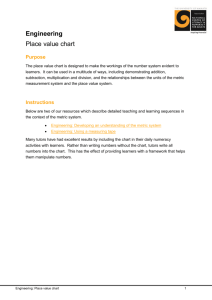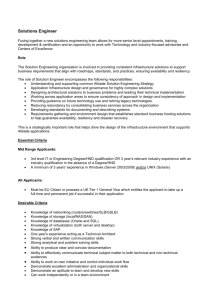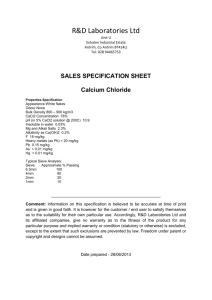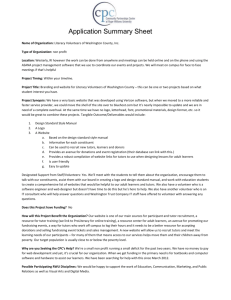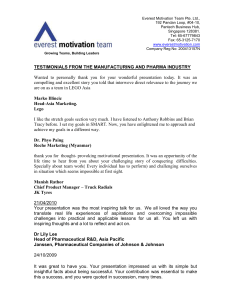Unit 13
advertisement
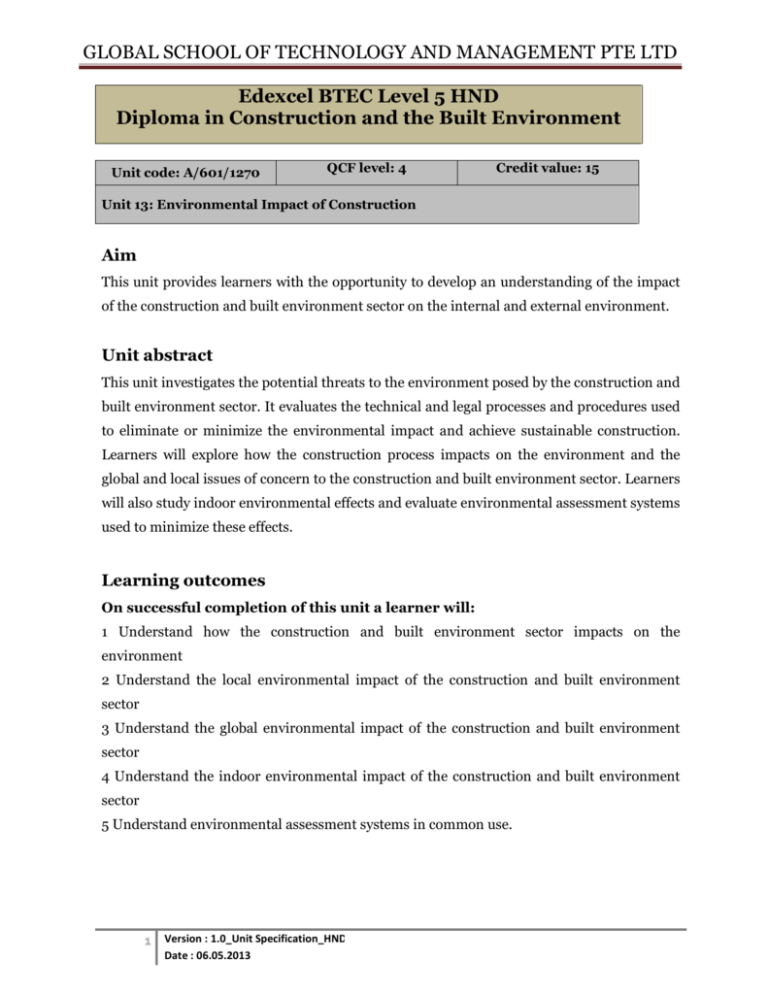
GLOBAL SCHOOL OF TECHNOLOGY AND MANAGEMENT PTE LTD Edexcel BTEC Level 5 HND Diploma in Construction and the Built Environment Unit code: A/601/1270 QCF level: 4 Credit value: 15 Unit 13: Environmental Impact of Construction Aim This unit provides learners with the opportunity to develop an understanding of the impact of the construction and built environment sector on the internal and external environment. Unit abstract This unit investigates the potential threats to the environment posed by the construction and built environment sector. It evaluates the technical and legal processes and procedures used to eliminate or minimize the environmental impact and achieve sustainable construction. Learners will explore how the construction process impacts on the environment and the global and local issues of concern to the construction and built environment sector. Learners will also study indoor environmental effects and evaluate environmental assessment systems used to minimize these effects. Learning outcomes On successful completion of this unit a learner will: 1 Understand how the construction and built environment sector impacts on the environment 2 Understand the local environmental impact of the construction and built environment sector 3 Understand the global environmental impact of the construction and built environment sector 4 Understand the indoor environmental impact of the construction and built environment sector 5 Understand environmental assessment systems in common use. Version : 1.0_Unit Specification_HND Date : 06.05.2013 GLOBAL SCHOOL OF TECHNOLOGY AND MANAGEMENT PTE LTD Unit content 1 Understand how the construction and built environment sector impacts on the environment Environmental impact: pre-construction; during construction; post-construction Pre-construction: location, extraction, transportation and refinement of raw materials; manufacture of construction materials and components During construction: noise from construction sites; dust, dirt and disturbance from construction sites; use of hazardous materials Post-construction: increased pressure on existing services; increased pressure on existing infrastructure; increased consumption of energy; increased production of greenhouse gases 2 Understand the local environmental impact of the construction and built environment sector Local environmental issues: air pollution; water pollution; increased water abstraction; noise pollution; contaminated land; remediation; landfill; waste management Methods used to reduce local environmental impact: legislation eg acts of Parliament, UK regulations, European Union (EU) directives; control eg Health and Safety Executive (HSE), local authority planning and environmental health departments; sustainable design eg improved energy efficiency, reduced embedded energy, specification of sustainable materials, recycling of materials and components; improved site management eg use of sustainable construction techniques, sharing of good practice, improved waste management, raising awareness, improved communication 3 Understand the global environmental impact of the construction and built environment sector Global environmental issues: global warming; deforestation; depletion of the ozone layer; acid rain; climate change; finite availability of fossil fuels; threat to habitats and biodiversity Methods used to reduce global environmental impact: ban on use of chlorofluorocarbons (CFCs); increased use of renewable energy sources; reduced reliance on coal; raising awareness; improved communication; Intergovernmental Panel on Climate Change (IPCC); international environmental conferences eg Kyoto (1997), Copenhagen (2009) 4 Understand the indoor environmental impact of the construction and built environment sector Indoor environmental issues: Sick Building Syndrome (SBS) eg modern artificial lighting, noise, Electromagnetic fields, radon, legionellosis, carbon monoxide, house dust mites, volatile organic compounds (VOCs) Version : 1.0_Unit Specification_HND Date : 06.05.2013 GLOBAL SCHOOL OF TECHNOLOGY AND MANAGEMENT PTE LTD Methods used to reduce indoor environmental impact: removal or modification of pollutant source; increasing ventilation rates; air cleaning; education; communication 5 Understand environmental assessment systems in common use Environmental assessment systems: required qualities (relevance, accuracy, reliability, validity); sections of Building Research Establishment Environmental Assessment Method (BREEAM) eg construction, maintenance, use and demolition of buildings, global issues, neighborhood issues and indoor effects, materials, services and techniques used to construct buildings, height and shape of buildings, characteristics of the site; home information packs (HIPs); energy performance certificates (EPCs) Version : 1.0_Unit Specification_HND Date : 06.05.2013 GLOBAL SCHOOL OF TECHNOLOGY AND MANAGEMENT PTE LTD Learning outcomes and assessment criteria Version : 1.0_Unit Specification_HND Date : 06.05.2013 GLOBAL SCHOOL OF TECHNOLOGY AND MANAGEMENT PTE LTD Guidance Links This unit links with other Edexcel BTEC HN Construction and the Built Environment units, for example: • Unit 1: Design Principles and Application for Construction and the Built Environment • Unit 7: Construction and Maintenance of Buildings • Unit 8: Technology of Complex Buildings • Unit 15: Production Management for Construction • Unit 17: Project Management for Construction and the Built Environment • Unit 20: Construction Methods and Design Solutions • Unit 24: Design Procedures for Construction • Unit 33: Civil Engineering Technology • Unit 37: Advanced Civil Engineering • Unit 39: Transportation for Construction and the Built Environment • Unit 47: Energy Utilisation and Efficiency for Building Services Engineering. The content of this unit has been designed and mapped against the current CIC National Occupational Standards and the current NVQs at levels 4 and 5. Completion of the learning outcomes will contribute knowledge, understanding and skills towards the evidence requirements of the NVQs. • See Annexe B for summary of mapping information to NVQs. This unit has also been mapped to illustrate the links to the NQF units. • See Annexe D for summary of mapping information to NQF units. Essential requirements Some of the issues dealt with in this unit are global in nature and, as a result, the relevant measuring equipment is not readily available. Relatively inexpensive and accurate equipment is available to measure the parameters associated with local environmental issues, such as air pollution and water pollution, and sound level meters are generally available in most centres. Local authority environmental services departments may be prepared to provide guest speakers or equipment on loan. Learners require access to copies of BREEAM and other environmental assessment methods. Useful source material is available, in bulk and at a Version : 1.0_Unit Specification_HND Date : 06.05.2013 GLOBAL SCHOOL OF TECHNOLOGY AND MANAGEMENT PTE LTD reasonable cost, from the National Society for Clean Air. Both Greenpeace and Friends of the Earth offer a similar resource. It is essential that a culture of health and safety is embedded in all the units to ensure that the learners understand the importance and relevance of health and safety issues. Therefore there should be clearly signposted aspects of current legislation and health, safety and welfare implications throughout the delivery and assessment of this unit. Employer engagement and vocational contexts Tutors should organise site visits, for example quarries, landfill sites and/or sustainable development materials processor. To ensure site visits are successful tutors should outline the aims and objectives of the visits, conduct preparatory briefings and encourage learners to review the site visits once completed. Tutors should organise presentations by visiting speakers, for example representatives from contractors, consultants, renewable energy companies and/or research agencies for example BRE. Tutors should use real-life case studies, based on site visits, for part of the assessment for this unit. Version : 1.0_Unit Specification_HND Date : 06.05.2013

